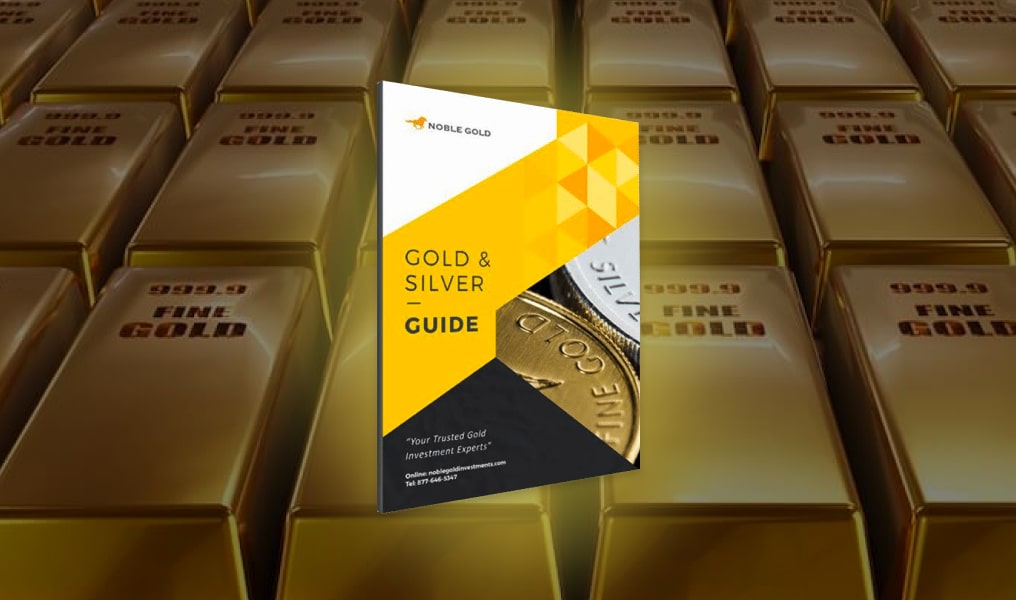Gold is popular among investors because it serves to hedge against inflation. You can directly invest in gold by purchasing bullion, such as gold coins or gold bars, but the associated fees can quickly add up. Owning physical gold comes with costs for storage, dealer commissions, insurance, and security.
Gold ETFs provide a seemingly simpler, cost-effective alternative to investing in gold. Rather than owning the physical metal, you’ll invest in a gold-backed fund that tracks the spot price of gold. However, when you invest in an ETF, you don’t actually own any of the underlying gold assets. Read on to learn more about the advantages & disadvantages of investing in a gold ETF.
What Is a Gold ETF?
Exchange-traded funds (ETFs) are pooled funds that you can trade just like individual stocks. Rather than focusing on one type of security, an ETF exposes you to multiple underlying securities. It tracks a specific index, commodity, or asset rather than a specific enterprise.
ETFs are a common alternative to mutual funds because you can buy and sell ETFs on a stock exchange.
A gold ETF specifically tracks the price movements of gold. Investors avoid the costs and logistics of owning physical gold. They own shares in a fund that lowers the risk factors of their portfolios. Since gold prices have a low correlation with the dollar’s value, it’s a smart addition to hedge against other volatile assets.
How To Invest in a Gold ETF
Before investing in a gold ETF, you should analyze your goals and investment strategy. ETFs are a relatively low-risk, inexpensive investment for balancing your portfolio when other segments are too volatile. Examine the gold ETFs you’re interested in and evaluate their holdings, costs, and performance.
Once you’ve decided, you can purchase gold ETFs like how you buy stocks on stock exchanges. ETFs go through online and traditional brokers, so you’ll have to set up a brokerage account if you don’t already have one. You can also purchase ETFs for your retirement account.
Gold ETFs have an expense ratio, an annual fee covering management and administration costs. Some ETFs have expense ratios of 0.40%, while others could be as low as 0.10% ($40 vs. $10 for a $10,000 investment). Investors emphasizing cost-effectiveness will want to look for gold ETFs with low expense ratios.
Advantages of a Gold ETF
Gold ETFs allow even beginner investors to buy into and track gold, whether it’s the spot price, a specific sector, or the gold mining industry you’d like to follow.
Gold is exceptionally popular for investors as a “safe haven” investment, but not everyone wants to (or can) spend the overhead costs of owning physical gold. ETFs generally have low risk and lower costs than actively managed funds.
Below are several advantages of investing in a Gold ETF:
Lower Fees
Gold ETFs have lower costs than actively managed funds because they only require passive management. The expense ratios of ETFs can be as low as 10% of a $10,000 investment, and some gold ETFs even offer commission-free trading. Owning physical assets can be quite expensive, including storage, commissions, security, and other fees.
Portfolio Diversification
Gold ETFs can expose you to a commodity or group of equities related to the gold industry. Investors looking to round out their portfolio, especially those with securities vulnerable to economic downturns, can benefit from buying into a gold ETF. Even if you don’t have the resources or need to own physical gold, you can still benefit from tracking the price of gold through an ETF.
Reinvested Dividends
Most gold ETFs combat dividend drag by reinvesting the dividends immediately. This feature ensures that investors in the fund compound their returns and obtain more shares over time, earning them more automatically-reinvested dividends.
Fluidity
Since gold ETFs trade on a stock market like regular stocks, they’re highly liquid and flexible. You can buy and sell ETFs without expensive overhead fees or administrative requirements. It’s more difficult to sell physical gold, and the liquidity varies depending on the kind of bullion you own. Coins are easier to liquidate because of their collectability, but finding a buyer for bars or rounds can be more challenging.
Minimal Overhead
You’ll have few overhead fees with owning gold ETF shares, but owning physical gold requires significant costs, including transportation, insurance, commissions, storage, and handling. Gold ETFs can be a much more inexpensive way to invest in gold rather than purchasing physical gold or investing in an actively-managed account. The lack of administrative costs is better for long-term investors.
Small Denomination
One of the best advantages of gold ETFs is that you can purchase them in small denominations. One unit of gold ETF shares equals one gram of gold. The ability to buy small amounts allows any investor to add gold to their portfolio without paying the high costs of owning gold bullion.
Hedge Against Inflation
Since gold retains its value during economic crises, sometimes even rising inversely to the dollar’s value, many investors buy physical gold to protect their assets during uncertain times. However, not everyone wants to handle pure gold or the expenses of storing it, so they often turn to gold ETFs.
Gold ETFs track the current market price of gold, so they have the same returns and risk-protection benefits as owning physical gold. However, rather than dealing with bullion, you’ll invest in gold like you would buy regular stocks.
Lower Discounts or Premiums
Many ETFs provide an intraday net asset value during market hours. Since investors trade ETFs throughout the day at a price near the actual value of the underlying securities, the discounts or premiums are nearly zero, and arbitrage helps fix any price variations. However, discounts and premiums might be lower or higher with international ETFs because of time differences.
Limited Capital Gains Tax
Usually, you have to pay taxes on your capital gains, which can be a considerable amount, depending on your income. Also, when you buy physical gold, you’ll have a sales tax, VAT, and wealth tax. Gold ETFs are much more tax efficient since they create fewer taxable events. Investors can defer taxes until they sell the ETFs, allowing them to strategize their taxes more effectively.
Similarities to a Stock
You trade ETFs on an exchange, just like equity. Each ETF has a ticker symbol you can use to look up the daily price, and the shares are as liquid as stocks. You can also use the same strategies you use for equity, such as purchasing on margin and selling short, trading on a real-time price, and trading futures and options.
Disadvantages of a Gold ETF
Like all investments, ETFs have their downsides. They’re a safe investment but might not have high yields compared to other assets. Not doing your research before buying an ETF can have consequences since certain ETFs are risky and more suitable for seasoned investors.
The following are some disadvantages of investing in a gold ETF:
Risk
Investors typically consider gold ETFs low in risk, but they involve similar risks to stocks. You trade ETFs on derivative markets using intraday pricing. For long-term investors, this level of reactionary trading might cause losses where end-of-day pricing protects from knee-jerk trades.
Wide Range of Options
You’ll have many gold ETFs from which to choose. The choices can be overwhelming for new investors. With so many types of ETFs that hold various securities in different sectors, inexperienced investors might struggle to figure out which gold ETF would serve their needs best.
Potentially Higher Costs
While investing in a gold ETF might be cheaper than owning physical gold because of the overhead costs, it can potentially be more expensive than investing in equity. You’ll pay a broker’s commission just as stocks, but you’ll also pay a management fee. Gold ETFs have an expense ratio, a certain percentage of your investment that you must pay annually.
Associated Fees
Gold ETFs have fees like other investment vehicles, including the expense ratio and commission each time you buy or sell shares. This means that both active traders and long-term investors need to factor these costs into their investment strategy. However, some gold ETFs offer commission-free trading.
Inability to Redeem for Physical Gold
Gold ETF account holders don’t allow investors to exchange their shares for physical gold. When you invest in a gold ETF, you buy gold-backed contracts rather than the commodity. You could liquidate your shares, but that defeats the purpose of purchasing the ETF as a hedge against inflation and other economic events.
Lower Dividend Yields
Taking on high-risk stocks can result in high yields, but ETFs are low-risk. Gold ETFs track a broader market, resulting in a smaller average yield. Individual stocks allow you to pick out equity with the highest dividend yield.
Skewed Leverage Returns
Leveraged ETFs sound attractive because of the possibility of doubling or tripling the returns. However, the losses can also multiply in a short time. The longer you hold the ETF shares, the more varied the overall return of the underlying security will be.
The Most Popular Gold ETFs
Before you commit to a particular gold ETF, it’s best to research the many types of gold ETFs available. You should assess the performance of various gold ETFs and determine whether it’s a good fit for your portfolio. It’s essential to understand the advantages & disadvantages of investing in a gold ETF before incorporating it into your investment strategy.
The following are a few of the most popular gold ETFs in the world:
SPDR Gold Shares – GLD
The SPDR Gold Shares ETF is the largest and most liquid gold ETF. The fund debuted on the New York Stock Exchange in 2004 and now holds 32 million ounces of gold bullion in the London HSBC vault. The ETF has $55.6 billion of assets under management (AUM), and each share gives fractional ownership of the fund’s gold held in trust.
The ticker for SPDR Gold Shares is GLD. You can purchase shares on an exchange just like you can with stocks, exposing you to gold’s spot price without buying and storing bullion. GLD has an expense ratio of 0.40%, about a $40 fee for a $10,000 investment.
SPDR Gold MiniShares – GLDM
Buy-and-hold investors could benefit from investing in SPDR Gold MiniShares rather than GLD. Investors still get beneficial ownership of physical gold bullion, but GLDM has a lower expense ratio, price per share, and bid-ask spread.
The expense ratio is only 0.10%, or $10 for a $10,000 investment. GLDM is one of the cheapest gold ETF options on the market, perfect for beginners and long-term growth.
iShares Gold Trust – IAU
The iShares Gold Trust ETF, with the ticker IAU, is a middle-of-the-road option compared to GLD and GLDM. IAU tracks London Bullion Market Association (LBMA) to expose investors to the spot price of gold and owns 16 million ounces of gold bullion.
This ETF has around $30 billion in AUM, and its expense ratio is 0.25% or $25 a year in fees for a $10,000 investment. IAU sits somewhere between GLD and GLDM, giving investors an excellent in-between option.
So Is A Gold ETF A Better Choice Than Physical Gold?
While the costs of investing in a gold ETF are typically lower than buying, storing, insuring, and shipping gold bullion, we believe the best way to invest in gold is to purchase physical gold.
Gold ETFs may be easier to acquire than physical gold, but when you invest in an ETF you don’t actually own any of the physical assets you’re “invested” in, you just own a piece of paper that says you own a piece of a fund that owns gold. This means in a situation where the economy was to collapse, it could be considerably harder to sell your shares in an ETF.
Whether you purchase physical gold to store at home or in a depository, or you purchase gold in a gold-backed IRA, at the end of the day those assets still belong to you. So even in a nightmare scenario where the economy collapses, you will still retain your physical precious metals which you can then sell for their full value if necessary.
If you have any questions about purchasing gold bullion or investing for retirement in a gold and silver IRA, feel free to give us a call today at 877-646-5437. Our experts are standing by and ready to answer any questions you may have and begin setting you up for future financial freedom.






